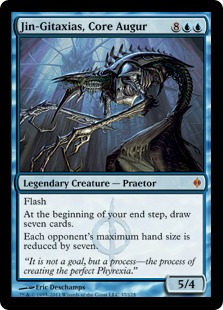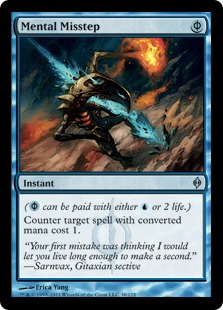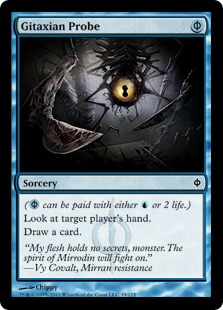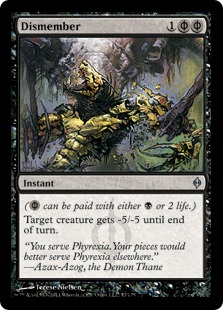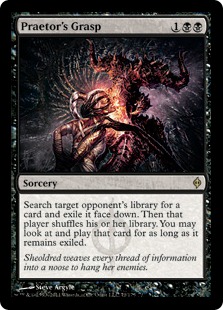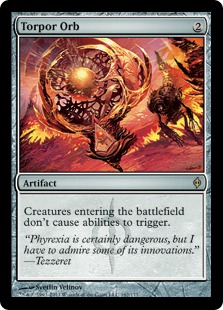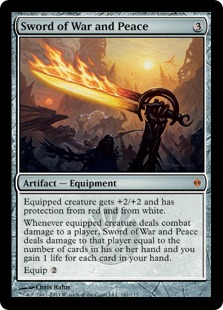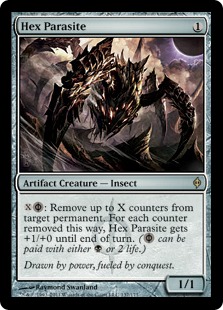Don’t miss Part One of Drew’s Set Review!
New set releases always leave me conflicted. On one hand, I love figuring out Constructed metagames. On the other hand, I love to brew. Piecing
together puzzles is at the very core of how and why I enjoy Magic. Figuring out what is, what can be, and what will be is a timeless and endless joy.
Metagaming is the feeling of going out at midnight, picking up Fallout: New Vegas, coming home, and spending the next thirty hours fighting through the
plot before anyone else.
The joy of brewing is getting to figure out why you needed all those Nuka-Cola Quantums. It’s a slog; you’re looking in the wrong place a
lot of the time, and you die a lot. Does it matter? Not really. You’re still in it to win—in this case, come up with some sick
deck—but “winning” in this scenario means something different. Sometimes it’s just figuring out that a card is a serviceable
role player in a playable archetype. Sometimes, it’s winning a Pro Tour because you figured out Sword of Feast and Famine before everyone else.
Victories come in all shapes and sizes, and we don’t improve as players or thinkers until we’re willing to engage with the “ugly”
cards, understand them on their own terms, grasp the outer limits of their utility, and then render a judgment.
When you look at a card, it’s important to think of not only what is, but what could be. Tarmogoyf was a dollar rare once upon
a time. Anyone who immediately dismisses a card with a unique functionality hasn’t thought enough about what they’re saying. Look for
upsides, and you’ll find rewards far more often than when you instinctively reject.
Today, I want to embrace brewing from the perspective of the metagamer. I am who I am: younger than most, less-accomplished than many, but a player
just like you—but I’m willing to think about this format in more depth than most people have time or patience to do on their own. All of
this by way of saying: I’m not here to sell cards; I’m here to encourage actual thought.
At least for this week, that is. I’ll butter your broccoli and cut your meat into perfectly bite-sized pieces next week, don’t worry.
It’s too easy to say “Jin-Gitaxias, Core Augur isn’t going to cut it in Reanimator. He’s too inconsequential a body, and you
put yourself on a six-turn clock as soon as he enters play.”
Sure, that’s all true, but you miss so much by doing that. You’re willfully depriving yourself of the few seconds it takes to reread the card,
think about every single word, and think about how those words fit into the puzzle of Legacy’s metagame.
The problem with Jin-Gitaxias in a traditional Reanimator shell is that, yes, he’s too low-impact. The issue with Reanimator has been its
difficulty in executing its setup. It’s hard to find a guy and a draw/discard spell or find an Entomb, resolve one or the other, find a Reanimate
or Exhume, resolve that, and make sure the creature is in your bin the entire time. That’s tough.
But here we have Jin-Gitaxias, this guy that isn’t even going to kill them on his own? That seems awful. We’re going to have to go through
this whole rigmarole again?
Well, not really, because we’re going to give them a one-turn window to have an answer, after which point they’re going to fight the rest
of the game with zero cards in hand and, probably, very few lands in play. Ah, the power of the full Mind Twist. Gotta love it.
Besides, we’re drawing seven cards every turn—we’re eventually going to find our way to kill them. I wouldn’t worry about any
of the drawbacks, really:
-Â Â Â Â Â Â Â Â Â If you’re scared of drawing your deck, put an Emrakul, the Aeons Torn in it.
-Â Â Â Â Â Â Â Â Â If you’re scared they’ll draw an answer to your Jin-Gitaxias, remember that
you’re outdrawing them eight-to-one, and you get to play counterspells.
-Â Â Â Â Â Â Â Â Â If you’re afraid that they’ll attack you to death in the first few turns, may I
suggest including something to hold them back?
-Â Â Â Â Â Â Â Â Â If you can’t think of a way to kill them while drawing eight cards a turn, keep reading.
One of the issues surrounding Jin-Gitaxias is that Reanimating him brings you down to ten life, at best. This makes another Reanimate either a major
liability or outright impossible unless you’re targeting Platinum Angel or Platinum Emperion. In either case, Jin plus Platinum is likely to be
“good enough”—you’ll draw into another Exhume or Reanimate to get your Iona or what-have-you and completely lock them. Reid
Duke wrote an article about that two weeks ago that
set me down this line of thought.
Of course, all of that isn’t actually winning a game, per se. It’s more not-losing than winning. What if, instead of building our
deck to not-lose, we built our deck to actually win? How would that look?
Creatures (8)
Lands (19)
Spells (33)

This deck has a deceptive amount of play to it. Keep in mind that Entomb says “card,” not “creature”: you’ll definitely end up
getting your Dread Return with this at some point.
With as few real reanimation targets as this deck has, Buried Alive is a clear better choice than Careful Study. As a rule of thumb, you want seven or
more creatures if you plan on having one for Careful Study in the first few turns. Since we only really want to get our Jin-Gitaxias into play, it
makes sense to play Buried Alive.
Our kill package is also rather tidy: with the right resources, we can just Buried Alive for the Kiki kill and Reanimate the Karmic Guide. This can
happen as early as turn one, provided we have a land, two Dark Rituals, Buried Alive, and Reanimate or Exhume. For the days where we don’t run
hotter than the sun, though, there’s Jin-Gitaxias to lock them out of having a hand for the rest of the game.
On a bad day, though, we can always just Buried Alive for Bloodghasts, play a land, and go to work in six-point increments. It isn’t pretty, but
it’s a real possibility. Cabal Therapy seems like an overperformer with this lineup, especially since we can set up our Jin-Gitaxias endgame with
a fetchland to recur Bloodghasts, Therapy away their relevant hand, crack the fetch for a land, trigger them again, and Dread Return our combo.
I actually don’t know if the Kiki kill is better than Necrotic Ooze/Phyrexian Devourer/Triskelion, but it seems better to not need a lot of cards
in our deck, especially considering we’ll be drawing eight a turn. I don’t want to need an Emrakul in a deck like this.
On a final note, yes, there are only fourteen blue cards for Force of Will. It’s on the low end, to be sure, but there are very few things this
deck actually cares to Force of Will. If you only want to cast one Force of Will in a game, you’ll usually be capable of doing so. Besides, what
are you going to do with those Brainstorms, anyway? Cast them? Not on your life.
One of the cards to which this deck is softest, unfortunately, is the near-consensus best Legacy card of the set. I already wrote an entire article on
it, so I’ll focus on its ramifications as opposed to its applications in this article, but trust me: Mental Misstep will be exactly as
influential as Gerry, Alex, Patrick, and I have been saying it will be.
Mental Misstep is not Just Another Spell Snare. Ari Lax made a good point in his recent article
on Mental Misstep, stating that “If your deck ceases to function smoothly without hitting its one-drop, it’s not an option any more.”
Even though Dark Confidant, Tarmogoyf, Hymn to Tourach, Painter’s Servant, Merchant Scroll, Infernal Tutor, and Lord of Atlantis all define the
format, Spell Snare is not a card that significantly changes things. Why? Because people don’t build around their twos like they build around
their ones.
For years, people have cheated on land counts in blue decks. Ponder and Brainstorm have held together countless mana bases, letting players play 18 or
20 land in decks with Jace, the Mind Sculptor. Counterbalance players have cheated on lands, too, keeping hands with one land and Sensei’s
Divining Top and hoping not to brick on their top three cards. That’ll have to end. People will still play Ponder and Brainstorm in blue midrange
decks, but they’ll get punished for running fewer than 22 or 23 lands.
Since people are less likely to resolve their key one-drops, games will move slower. Decks may shift to focus on Legacy’s powerful twos. Other,
slower decks like Life from the Loam that were suppressed by Counterbalance and fast combo may return to the metagame. If the metagame slows down
enough, cards that produce real card advantage—like Standstill or Ancestral Vision—may become more viable.
Mental Misstep will also further push out the Stifle/Wasteland strategies that occasionally crop up in Legacy, as Stifle will no longer be nearly as
good against blue decks as it has been. In the past, blue decks would have to either wait on their fetchland activations, walk them into Stifle, or
fight the Stifle with Force of Will, which itself could get Dazed for maximum value. Now, Mental Misstep can fight Stifle on a one-for-one basis,
making a mana denial strategy that much worse.
If there’s less focus on low-curve interaction coupled with mana denial, and blue decks are playing more lands to cover their bases on getting
cantrips Misstepped, that opens the door for an aggressive strategy to wreak havoc in the metagame. If that strategy weren’t overly vulnerable to
Mental Misstep or played its own Missteps, it would be very well-positioned.
Oh, right, it exists, and it’s called Merfolk. I feel a bit like a broken record, but the second thing that people are going to have to plan
against in this new Legacy format (after Mental Misstep) is Lord of Atlantis. I’m still working on that part. Here’s hoping I figure it out
before Orlando…
Finally, I want to talk about Gitaxian Probe.
I got a lot of questions about Gitaxian Probe’s viability in a broad range of decks. Really, its practicality depends on whether you want a Peek
or a Street Wraith for what you’re doing.
The first place that people looked to slot Probe was in Belcher. Unfortunately, this is an awkward home for the card, as Belcher has access to Street
Wraith already. The value of a Peek in a combo deck is to figure out if your combo hand can beat their resistance hand. If it can, go ahead and kill
them. But if your hand can’t beat their resistance? Well, then, you pass the turn, right? I mean, you’re not winning this turn—we
just established that your hand isn’t beating theirs.
The problem is that for the “sit and wait” strategy to be a winning one, your deck must be capable of improving its hand better than their
deck can improve their hand. Belcher is phenomenally bad at improving its hand, largely because it has no draw engine and no card selection engine.
Gitaxian Probe is pretty much only a Street Wraith in Belcher, since you don’t have the luxury of waiting for your hand to get better—you
don’t play Duress or Force of Will, and that Force of Will of theirs is still going to be there in three turns when you cast Burning Wish.
So where is Gitaxian Probe going to fit in? I think there are two real possibilities. The first is in High Tide, for its Peek functionality. High Tide,
unlike Belcher, can do something about the texture of its hand against resistance. Phyrexianing out a turn one Probe will give a High Tide
player a huge advantage in Pondering and Preordaining, as now they know exactly what they’re up against. If they Ponder into a Force of Will on
the play with one other copy in hand, are they supposed to draw it? Before Probe, you’d have to guess. With Probe, you can make informed
decisions about which resources to prioritize at any given point in a game. In that sense, then, Gitaxian Probe is a very blue card, as it plays well
with the ability to manipulate one’s deck and hand to better suit a matchup.
Gitaxian Probe also fits rather well into a Life from the Loam-based midrange control deck that plays Devastating Dreams. Since Dreams requires its
caster to go all in on casting the spell, having Gitaxian Probe determine whether the path is clear can be invaluable. If they don’t have the Force of
Will, go right ahead with the Armageddon + Wrath plan. If they do have countermagic in store for you, you can dredge Life from the Loam with
Probe’s “draw a card” text, wait a turn, and try to hit a Cabal Therapy to clear the way for your game-breaking spell. Of course,
this is hardly limited to Life from the Loam decks—it’s very reasonable to expect Probe and Therapy to show up together in black-based
disruption decks that can’t afford to miss with Therapy, yet want the additional disruption that it provides.
The theme of “Phyrexian mana is going to be very powerful in Legacy” doesn’t stop with blue cards. Black has two very good
Phyrexian-mana cards. First, Dismember:
Several of my friends have taken to calling this “the blue Snuff Out.” Indeed, this is definitely one of the best pieces of removal that a
mono-blue deck in Legacy can play this weekend. High Tide can finally Wish for a way to kill Ethersworn Canonist and Gaddock Teeg that isn’t
Slaughter Pact, which is nothing to sneeze at. Merfolk decks can kill Peacekeeper and Llawan, Cephalid Empress. For one colorless mana, any deck in
Legacy can kill 95% of the relevant creature base, with the notable exceptions of the occasional Tarmogoyfs and Knights of the Reliquary as well as the
typically unkillable Emrakul and Progenitus.
Dismember raises an interesting question: how much do people care about killing creatures? Is there a deck out there that really needed a way to kill a
creature without dipping into black or white? Is there some insane U/G deck that has its one-mana removal spell in Dismember and can really take off? I
don’t know about a U/G deck specifically, but the existence of Dark Confidant has certainly limited decks that couldn’t compete with The
Great One’s drawing power. To return to High Tide: it’s very, very difficult for any combo deck to beat a resolved Dark Confidant that
sticks around a turn or two, since it provides a clock and a steady stream of disruption. Do I think that High Tide would be willing to pay four life
and one mana to kill a Dark Confidant? Absolutely.
The other black Phyrexian-mana Legacy role player is Surgical Extraction.
Like many other Phyrexian-mana cards, Surgical Extraction is most notable for what it does outside of its assigned color. Black already has Extirpate,
a near carbon copy of Surgical Extraction. So what do the other four colors gain from a free—albeit counterable—Extirpate?
I suppose it depends on how dominant any “one-card deck” is. Tormod’s Crypt is another free way to hate out someone’s
graveyard, so we’re unlikely to make many inroads there. This card is about ripping out the very backbone of a deck, leaving it crippled and
incapable of much more than floundering around like a fish out of water. Tormod’s Crypt is at its best against Dredge, Cephalid Breakfast, and so
on. Surgical Extraction seems like a very strong card against any resurgent Life from the Loam strategies that might come out of a New Phyrexian
metagame.
I want to caution all those of you who think that Surgical Extraction is for use as a “value card”: it’s not. I know people who swear
by Extirpate’s applications against midrange blue decks as a means of gaining inevitability. “After all,” the argument goes,
“if I Extirpate their Swords to Plowshares, I’ll definitely kill them with my Knight of the Reliquary.” The problem is that they
still have Jace, the Mind Sculptor; they still have countermagic; and they still have their creatures. Meanwhile, you’re down a card in a matchup
focused mainly on attrition. Less than ideal, really. If you ever get the itch to board in Extirpates or Surgical Extractions against a nonlinear deck,
make sure you have a very good idea of what card you’re going after, how you’re going to get it into their graveyard, and how the game will
proceed from there. Without a detailed plan, Surgical Extraction (and Extirpate) can easily become ways to put yourself down a card in a game with far
fewer dead cards.
If you want to truly cripple an opponent with an Extract offshoot, though, New Phyrexia has a good option for you. Check out Praetor’s Grasp:
Praetor’s Grasp is going to be absolutely insane in the Tendrils mirror. Since most Tendrils decks play one Ad Nauseam, one Ill-Gotten Gains, and
one Tendrils of Agony, you can hijack their only win condition in the mirror, hide it from their Duresses and Thoughtseizes, and use it to kill them a
few turns later!
Of course, the natural reaction will be to board in Dark Confidants, more Tendrils of Agony, and even Jace, the Mind Sculptor to combat this threat. If
that becomes the norm, expect Sadistic Sacrament to see more play. Sacrament was the combo mirror breaker of choice for Grand Prix Madrid. Granted,
Mystical Tutor made it easier to play exactly one copy and still see it with alarming regularity, but Praetor’s Grasp is a different card from
Sadistic Sacrament. Assuming you’re playing U/B Tendrils, you can steal a Jace, the Mind Sculptor from a control player and use it to get far,
far ahead of them on cards. If you already have the combo in-hand, you could steal one of their Force of Wills and protect your combo with it. Although
it’s unlikely to see play in aggressive or controlling decks, I love its versatility in a lot of Legacy combo decks.
Finally, we come to New Phyrexia’s artifacts. Let’s start with the one that’s gotten the most press in recent weeks:
Torpor Orb is a pretty unimpressive card in the context of Legacy as a format. The best creatures are either just Big—Emrakul, Progenitus, even
Tarmogoyf—or have abilities that happen every turn—Knight of the Reliquary, Dark Confidant, and Lord of Atlantis. Granted, it does hose
Stoneforge Mystic, Vendilion Clique, and Sower of Temptation, but that’s about the extent of its defensive capacities. Since we’re not
stopping much with this card, what is it doing for us? Well, as it turns out, it’s the newest way to Stifle the comes-into-play trigger from
Phyrexian Dreadnought and Hunted Horror. Torpor Orb is a preemptive Stifle, making it possible to play eight (or even more!) boom-booms in your
cheats-style deck.
Part of what makes this deck so interesting is that its design is wide open: Torpor Orb, Phyrexian Dreadnought, and Hunted Horror only make you commit
to black, giving you endless options on color splashes and role assessment. A Torpor Orb deck could be beatdown with eight over-the-top finishers; it
could be a black disruption deck; it could be a blue control deck; or it could even be a sideboard transformation from a base-black combo deck. As a
strong build-around-me card in Legacy, I’m interested to see where Torpor Orb ends up.
Next up is the equipment threatening to flip Standard on its head, Sword of War and Peace:
Although Sword of Fire and Ice will likely never relinquish its title of “Best Sword in Legacy,” a good argument can be made for Sword of
War and Peace in the format. It’s very clearly cut out to be an anti-control card in this incarnation of Legacy. As I mentioned earlier, control decks
will have the opportunity to slow down and pursue actual card advantage in a format with Mental Misstep. This strength is also a weakness—one
exploited rather nicely by Sword of War and Peace. If the removal package of the new base-blue control decks is red and/or white, it’s very possible
that we could see a Stoneforge Mystic crash past a Jace, the Mind Sculptor for ten damage in Legacy.
During Scars of Mirrodin’s release, I remember discussing the strengths of Phyrexian Crusader with several teammates. They were making the same
point—if Phyrexian Crusader sees play, it will be because of its protection abilities. Right now, control decks lean heavily on white and red
removal. If that changes, Crusader’s potential would decline.
We’re about to run into a format where we don’t know what color of removal control decks will be playing. If they’re on an AJ
Sacher-like Grim Lavamancer + Fire / Ice package, Sword of War and Peace could be pretty decent. Of course, Sword of Fire and Ice will be better in
that particular situation, but someone has to bat second. Besides, if the aggressive decks are playing white creatures with white removal spells, I can
think of one way to break the mirror open…
Finally, a card from the world of “it can only ever get better.” In fairness, Hex Parasite is starting out pretty close to being
Legacy-playable as it is.
Hex Parasite feels like the middle ground between a Phyrexian Revoker and a Pithing Needle. Pithing Needle is always a sunk investment; it always
“costs” a card. Phyrexian Revoker is a decent attacker and can get stuck in for a surprising amount of damage in a control mirror. Hex
Parasite, on the other hand, is in an odd place. It’s a very clear Trinket, yet there aren’t a whole lot of counters to be removed in
Legacy right now.
Hex Parasite’s best work is likely to come from killing Jaces for four mana and two life. It’s pretty difficult to kill Jace in a blue
mirror no matter how hard you try, so having a way to Trinket Mage for a Jace-killer that doesn’t neuter your own Jaces is a welcome addition to
the format.
I suppose one “dream” would be ambushing an Engineered Explosives and devouring its sparkle, giving Hex Parasite some work in aggressive
strategies. Still, this feels like a wait-and-see card. Outside of Jace, the Mind Sculptor and Engineered Explosives, there aren’t a lot of
counters to be eaten in today’s metagame. That could certainly change at a moment’s notice, perhaps even enough to bolster Trinket
Mage’s stock alongside Hex Parasite’s ascendance. I would keep one or two in your binder, just in case.
That’s it for my take on New Phyrexia’s potential for Legacy. I’ll be back next Wednesday with a much more traditional article
straight from the Orlando StarCityGames.com Legacy Open. Until then, I’d love to hear your feedback in the forums, regardless of whether you
loved or hated this style of article.
Good luck brewing!
Â
Until next week,
Drew Levin
@mtglegacy on Twitter

